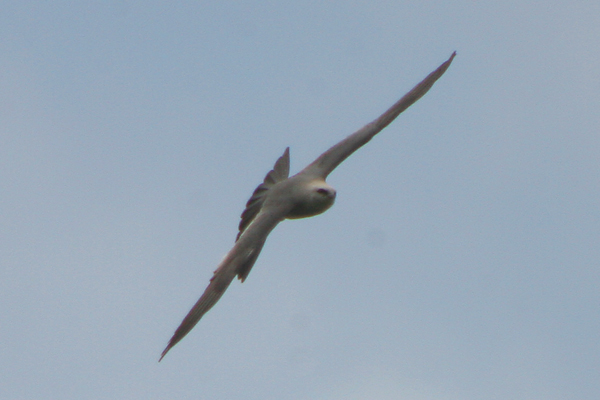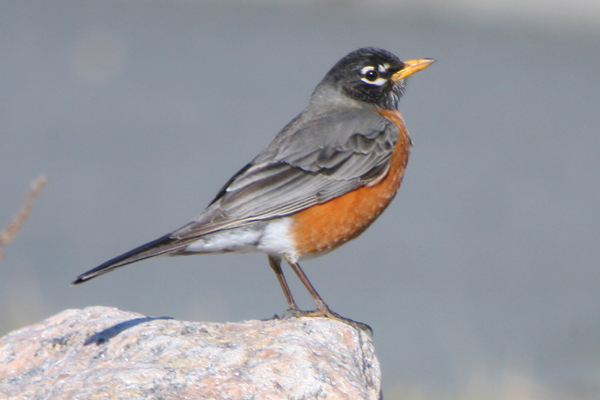I’ve finally done it! More than a year and a half since my first foray into international birding I finally decided on a checklist, figured out what birds I have seen, and put them in taxonomic order with date and location information from my first sighting for the whole world to see! You can check out my world life list which stands at 776 species as of this writing, right here. It only took me a little over a month of spare time to get it together, you know, when I would normally be doing something really worthwhile like surfing the internet or harassing one of my cats.
Putting together a life list is not the easiest of things to do. First, one must choose what list to list on. Wait, there’s more than one world birding checklist? Oh my, yes. One can list on Clements, Sibley and Monroe, Howard and Moore, or, as I did, the International Ornithological Congress (IOC) list. Why did I choose to use the IOC? I think that checklists should be created and maintained with the highest levels of scientific vigor and the most input possible. The wiki-like approach taken by the IOC is marvelous. I also find it admirable that the IOC seeks to unify British and American common names for birds.
The other lists just don’t have that same level of international participation and openness. Though the Clements list is now in the hands of the Cornell Lab of Ornithology, an institution known for it’s fostering of citizen science initiatives and for which I have the greatest respect, I still think that the IOC is the better organization to take an international participatory perspective (especially considering that Cornell defers to the American Ornithologist’s Union for all of the birds of the Western Hemisphere, an organization that has both a North American Checklist Committee and a South American Classification Committee that have sometimes contradictory checklists). The other two world checklist options just don’t compare, especially when one considers the amount of effort that has to go into keeping a checklist of over 10,000 species up to date with the latest science.
It’s odd listing on a new checklist. Bird families are in very different locations on the IOC list than they are on the American Birding Association checklist on which I keep (what else?) my ABA life list, which, as of this writing, is not too shabby, clocking in at 439 species. The ABA checklist starts with whistling ducks and geese while the IOC list starts with ratites. Instead of House Sparrow bringing up the tail end of my list I have Painted Bunting there. Of course, there are many more differences between the two but there is no need to go into the gory details: check out the checklists yourself if you are interested in learning more.
Figuring out what bird is what can be quite pain as well, especially for birds I don’t know that well like the birds I saw in Kazakhstan. Seeing a Great Black-headed Gull is great but then not finding it on the checklist is kind of odd. Fortunately, a quick google search of almost any bird name usually quickly nets the searcher with alternate common names (in this case, Pallas’s Gull), and, most importantly, the scientific name (Ichthyaetus ichthyaetus). I never really grasped how important scientific names are until I started figuring out my world checklist. Most birds have had at least a couple of common names in English and when one takes into account the fact that pretty much every species has common names in multiple languages, well, good old binomial classification helps a great deal! So, for the first time on one of my bird lists, I have included the scientific name of each species, and, where a common name is used at least as frequently as the common name the IOC chose, I add that common name as well.
So, please, take a moment or two and take a look at the life list I have amassed and carefully collated. If you find any errors please put them in the comments here…and if you have any questions or suggestions about world life listing by all means feel free to put them in the comments too. I am rather new at this game after all, and I am quite sure that some of you out there reading this blog must be thinking to themselves, “Man, the IOC list?!?! What a dummy! He should be using XYZ list and this is why!” or “What a waste of time it is to keep a life list. He should just enjoy seeing the birds” or “This post is really boring. I think I’m going to turn the computer off and go eat some pie.” Whatever you’re thinking, feel free to share. And good luck getting your own life list sorted out and growing!













776 species!! It’s certainly amazing! I was just wondering on how to make a list of those birds I’ve seen so far. Although, identifying birds can be very difficult at times, which is why I’m forced to ask a very silly question here: how do you identify the birds you see, their name along with other details? I recently started bird watching and I’ve no idea which book or website to refer, particulary when there’s no photo record.
I heard the IOC was going to start testing for doping in the sport or am I thinking of a different IOC? 🙂
The IOC always seemed a little split-happy to me, but all of the world compilers have their strengths and weaknesses so I can’t really say whether that’s a bad thing or not. I definitely like that way they’re trying to coordinate all the common names of birds across all continents, though. That’s a big and thankless job.
But I shouldn’t really talk, my world list is organized by whatever list the field guide for the country I’m in uses and is likely completely inconsistent so my real number is a rough estimate at best.
Any organization is better than no organization, I suppose.
Also, with a life list of 776 and a year list of 555, isn’t it weird to think that you’ve seen 2/3 of all the bird species you’ve ever seen just in the first half of this year? 🙂
Nice, congrats on getting it pulled together!
For the record, of the major world lists, Howard and Moore maintains the most rigorous scientific citations and is respected for that reason. But the list is largely inaccessible unless you want to buy an expensive book every few years or buy software that licenses it.
The IOC list committee started publishing the list online in mid-2007. They publish updates several times a year, which allows them to respond quickly to new information and studies (perhaps too quickly sometimes, but I prefer that to the alternative). And as you say, they are quite responsive to feedback and suggestions. They have recently reverted several novel nomenclatural suggestions that weren’t well received around the world. That said, it’s not perfect, and I’m not convinced that English names need to be “standardized,” but I think it’s an excellent list with a lot of credibility behind it.
The variety of formats in which the list is freely available and the frequency of updates are unparalleled. If you use Birdstack, which is based on the IOC list, you can benefit from automatic taxonomic updates and a community-driven system of alternate English name suggestions. Avibase is an excellent resource for comparing English and scientific names across major world lists.
Anyway, happy listing!
(Disclosure for those who don’t know: I am a volunteer contributor to the IOC World Bird Names project and am co-owner of Birdstack.)
I use the IOC, too. You’ll have to fix all the misspellings of “Gray” and “Colored”, and change the execrable “Divers” back to the respectable “Loons,” and ditch “American” in front of Yellow Warblers and Herring Gulls… But once you scrub all that nasty limey off our New World birds, it’s servicable.
Remember too that the website for the IOC has an excellent concordance of the Clements names and the IOC names–I use it every day.
@Fatima: get a field guide that covers birds where you live and and pair of binoculars and start learning. You can also probably find a local bird club to help you get started.
@Will: Testing the birds or the birders?
@Nate: Split-happy is good! And, yes, it is very weird to think that I have seen 2/3 I have ever seen in just the first half of this year. bet that never happens again!
@David: Thanks for the info (and the shameless plug). 🙂
@Paul: Exactly. Those crazy anglophiles with their bizarre spellings…
@Rick Wright: Thanks for that extra bit of info…
Hi there, Corey!
A nice website! However, I expected finding a link to your major source of reference, the IOC checklist. That’s one thing. The other is your claiming credit for the Avibase lists which are, in my opinion, the most faulty in the Internet. Initially I also began by referring to them when starting my personal project since it is the first one runs into when searching the Internet. I soon found out, though, that they are so full of mistakes, in content and in language, that I won’t even look into them anymore. I am a Dutch ornithologist, a serious hobby birder since my 12th year, and currently working on a 10-language compendium of all holarctic bird names. Avibase is so embarrasingly bad in many languages that I wish they had been less pretentious by limiting themselves to, say, English and French (being a Canadian outfit).
I agree with you that the IOC is the only truly and fairly oriented international ornith. organization. Unfortunately, the AOU is too North-America-orientaed and actually refuses to work with the IOC and BirdLife Int’l. Too bad, as there are enough problems in the international scene to extend these to scientific fields. The most desturbing problem I encounter here is the lack of cooperation in reaching agreement on the taxonomic structure. Surely, newly acquired knowledge will continually cause necessary adjustments. But I think they ought to come together on basic structure, especially where Orders and families are concerned.
I wonder what you think of this and what you think of the differences between the Zoonomen structure and that of the IOC. Anyway, good luck with your birding and your personal checklist!
All the best, Ad Tolhuijs (Kanalstrasse 34; 8575 Buerglen; Switzerland; +41-71-630 0830; ad@tolhuijs.com
@Ad: Thanks for your comment!
I DID link to the IOC list and I did not “claim credit for the Avibase lists” so I am not sure of those criticisms.
As for the AOU, well, I don’t know much about who they will and will not work with but I do know that an organization that isn’t internally consistent in their listing is a questionable authority for a checklist. I am actually considering making the jump to Birdstack from eBird simply because Birdstack uses the IOC list.
And I will say that I am in over my head a bit when trying to compare the Zoonomen structure with the IOC…frm what little I know of world bird lsiting I like the IOC model the best for its accessibility, wiki-style, and ease of use.
10.08.2016
Dear Corey
Arrived at this website by strange coincidence. Anyway, the stuff we “discussed” in 2009 is really old hat and ought to be erased. Sorry for the comments that were partially just a bit too hardly verbalized.
Hope you are doing well – I am: birding and photographing in Oregon, and catching big fish as well. Take care, Ad